A Simple Fractal-Based Model for Soil-Water Characteristic Curves Incorporating Effects of Initial Void Ratios
Abstract
:1. Introduction
2. Proposed Model
2.1. Fractal Description of a Soil
2.2. Fractal-Based Model for Variation of Soil-Water Characteristic Curve (SWCC) with Initial Void Ratio
2.3. Determination of Model Parameters
2.3.1. Fractal Dimension at Reference State
2.3.2. Fractal Dimension at Deformed State
2.3.3. Air-Entry Value at Reference State
2.3.4. Air-Entry Value at Deformed State
3. Model Validation
3.1. Wuhan Clay
3.2. Hefei and Guangxi Expansive Soils
3.3. Saskatchewan Silt
3.4. Loess
4. Discussion
5. Conclusions
Author Contributions
Acknowledgments
Conflicts of Interest
References
- Fredlund, D.G.; Xing, A.; Fredlund, M.D.; Barbour, S.L. Relationship of the unsaturated soil shear strength to the soil-water characteristic curve. Can. Geotech. J. 1996, 33, 440–448. [Google Scholar] [CrossRef]
- Wheeler, S.J. Inclusion of specific water volume within an elasto-plastic model for unsaturated soil. Can. Geotech. J. 1996, 33, 42–57. [Google Scholar] [CrossRef]
- Assouline, S. A model for soil relative hydraulic conductivity based on the water retention characteristic curve. Water Resour. Res. 2001, 37, 265–271. [Google Scholar] [CrossRef] [Green Version]
- Gallipoli, D.; Gens, A.; Sharma, R.; Vaunat, J. An elasto-plastic model for unsaturated soil incorporating the effects of suction and degree of saturation on mechanical behaviour. Geotechnique 2003, 53, 123–135. [Google Scholar] [CrossRef] [Green Version]
- Fredlund, D.G.; Rahardjo, H.; Fredlund, M.D. Unsaturated Soil Mechanics in Engineering Practice; John Wiley & Sons: Hoboken, NJ, USA, 2012; Volume 132, pp. 286–321. [Google Scholar]
- Van Genuchten, M.T. A closed-form equation for predicting the hydraulic conductivity of unsaturated soils. Soil Sci. Soc. Am. J. 1980, 44, 892–898. [Google Scholar] [CrossRef]
- Fredlund, D.G.; Xing, A. Equations for the soil-water characteristic curve. Can. Geotech. J. 1994, 31, 521–532. [Google Scholar] [CrossRef]
- Haj, K.M.A.A.; Standing, J.R. Soil water retention curves representing two tropical clay soils from Sudan. Geotechnique 2015, 66, 1–14. [Google Scholar]
- Brooks, R.H. Hydraulic Properties of Porous Media; Colorado State University: Fort Collins, CO, USA, 1964; Volume 3, pp. 352–366. [Google Scholar]
- Romero, E.; Vecchia, G.D.; Jommi, C. An insight into the water retention properties of compacted clayey soils. Geotechnique 2011, 61, 313–328. [Google Scholar] [CrossRef]
- Simms, P.H.; Yanful, E.K. Predicting soil-water characteristic curves of compacted plastic soils from measured pore-size distributions. Geotechnique 2002, 52, 269–278. [Google Scholar] [CrossRef]
- Chan, T.P.; Govindaraju, R.S. A new model for soil hydraulic properties based on a stochastic conceptualization of porous media. Water Resour. Res. 2003, 39, 1195. [Google Scholar] [CrossRef]
- Salager, S.; Nuth, M.; Ferrari, A.; Laloui, L. Investigation into water retention behaviour of deformable soils. Can. Geotech. J. 2013, 50, 200–208. [Google Scholar] [CrossRef] [Green Version]
- Zhou, A.-N.; Sheng, D.; Carter, J.P. Modelling the effect of initial density on soil-water characteristic curves. Geotechnique 2012, 62, 669–680. [Google Scholar] [CrossRef]
- Assouline, S. Modeling the relationship between soil bulk density and the water retention curve. Vadose Zone J. 2006, 5, 554–562. [Google Scholar] [CrossRef]
- Ng, C.W.W.; Pang, Y.W. Influence of stress state on soil-water characteristics and slope stability. J. Geotech. Geoenviron. Eng. 2000, 126, 157–166. [Google Scholar] [CrossRef]
- Gallipoli, D.; Wheeler, S.J.; Karstunen, M. Modelling the variation of degree of saturation in a deformable unsaturated soil. Geotechnique 2003, 53, 105–112. [Google Scholar] [CrossRef] [Green Version]
- Wheeler, S.J.; Sharma, R.S.; Buisson, M.S.R. Coupling of hydraulic hysteresis and stress–strain behaviour in unsaturated soils. Geotechnique 2003, 53, 41–54. [Google Scholar] [CrossRef]
- Sun, D.A.; Sheng, D.; Cui, H.B.; Sloan, S.W. A density-dependent elastoplastic hydro-mechanical model for unsaturated compacted soils. Int. J. Numer. Anal. Methods Geomech. 2007, 31, 1257–1279. [Google Scholar] [CrossRef]
- Khalili, N.; Habte, M.A.; Zargarbashi, S. A fully coupled flow deformation model for cyclic analysis of unsaturated soils including hydraulic and mechanical hystereses. Comput. Geotech. 2008, 35, 872–889. [Google Scholar] [CrossRef]
- Miller, G.A.; Khoury, C.N.; Muraleetharan, K.K.; Liu, C.; Kibbey, T.C.G. Effects of soil skeleton deformations on hysteretic soil water characteristic curves: Experiments and simulations. Water Resour. Res. 2008, 44, 137–148. [Google Scholar] [CrossRef]
- Nuth, M.; Laloui, L. Advances in modelling hysteretic water retention curve in deformable soils. Comput. Geotech. 2008, 35, 835–844. [Google Scholar] [CrossRef]
- Masin, D. Predicting the dependency of a degree of saturation on void ratio and suction using effective stress principle for unsaturated soils. Int. J. Numer. Anal. Methods Geomech. 2010, 34, 73–90. [Google Scholar] [CrossRef]
- Sheng, D.; Zhou, A.N. Coupling hydraulic with mechanical models for unsaturated soils. Can. Geotech. J. 2011, 48, 826–840. [Google Scholar] [CrossRef]
- Tarantino, A. A water retention model for deformable soils. Geotechnique 2009, 59, 751–762. [Google Scholar] [CrossRef]
- Gallipoli, D.; Bruno, A.W.; Onza, F.D.; Mancuso, C. A bounding surface hysteretic water retention model for deformable soils. Geotechnique 2015, 65, 793–804. [Google Scholar] [CrossRef]
- Wei, W.; Cai, J.; Hu, X.; Han, Q.; Liu, S.; Zhou, Y. Fractal analysis of the effect of particle aggregation distribution on thermal conductivity of nanofluids. Phys. Lett. A 2016, 380, 2953–2956. [Google Scholar] [CrossRef] [Green Version]
- Wei, W.; Cai, J.; Hu, X.; Han, Q. An electrical conductivity model for fractal porous media. Geophys. Res. Lett. 2015, 42, 4833–4840. [Google Scholar] [CrossRef] [Green Version]
- Cai, J.; Hu, X.; Xiao, B.; Zhou, Y.; Wei, W. Recent developments on fractal-based approaches to nanofluids and nanoparticle aggregation. Int. J. Heat Mass Transf. 2017, 105, 623–637. [Google Scholar] [CrossRef] [Green Version]
- Cai, J.; Wei, W.; Hu, X.; Liu, R.; Wang, J. Fractal characterization of dynamic fracture network extension in porous media. Fractals 2017, 25, 1750023. [Google Scholar] [CrossRef]
- Cai, J.; Hu, X. Fractal Theory in Porous Media and its Applications; Science Press: Beijing, China, 2015. [Google Scholar]
- Zolfaghari, A.; Dehghanpour, H.; Xu, M. Water sorption behaviour of gas shales: II. Pore size distribution. Int. J. Coal. Geol. 2017, 179, 187–195. [Google Scholar] [CrossRef]
- Shi, Y.; Yassin, M.R.; Dehghanpour, H. A modified model for spontaneous imbibition of wetting phase into fractal porous media. Colloids Surf. A Physicochem. Eng. Asp. 2018, 543, 64–75. [Google Scholar] [CrossRef]
- Bird, N.R.A.; Perrier, E.; Rieu, M. The water retention function for a model of soil structure with pore and solid fractal distributions. Eur. J. Soil Sci. 2000, 51, 55–63. [Google Scholar] [CrossRef]
- Xu, Y.F.; Sun, D.A. A fractal model for soil pores and its application to determination of water permeability. Physica A 2002, 316, 56–64. [Google Scholar] [CrossRef]
- Russell, A.R. How water retention in fractal soils depends on particle and pore sizes, shapes, volumes and surface areas. Geotechnique 2014, 64, 379–390. [Google Scholar] [CrossRef]
- Huang, G.; Zhang, R. Evaluation of soil water retention curve with the pore–solid fractal model. Geoderma 2005, 127, 52–61. [Google Scholar] [CrossRef]
- Khalili, N.; Khoshghalb, A.; Pasha, A.Y. A fractal model for volume change dependency of the water retention curve. Geotechnique 2015, 65, 141–146. [Google Scholar]
- Tao, G.L.; Zhang, J.R. Two categories of fractal models of rock and soil expressing volume and size-distribution of pores and grains. Sci. Bull. 2009, 54, 4458–4467. [Google Scholar] [CrossRef]
- Tao, G.L.; Zhang, J.R.; Zhuang, X.S.; Yang, L. Influence of compression deformation on the soil-water characteristic curve and its simplified representation method. J. Hydraul. Eng. 2014, 45, 1239–1245. [Google Scholar]
- Russell, A.R.; Buzzi, O. A fractal basis for soil-water characteristics curves with hydraulic hysteresis. Geotechnique 2012, 62, 269–274. [Google Scholar] [CrossRef]
- Miao, L.; Jing, F.; Houston, S.L. Soil-water characteristic curve of remolded expansive soils. In Proceedings of the Fourth International Conference on Unsaturated Soils, Carefree, Arizona, 2–6 April 2006; pp. 997–1004. [Google Scholar]
- Huang, S. Evaluation and Laboratory Measurement of the Coefficient of Permeability in Deformable. Ph.D. Thesis, University of Saskatchewan, Saskatoon, SK, Canada, 1994. [Google Scholar]
- Wang, T.H.; Lu, J.; Yue, C.K. Soil-water characteristic curve for unsaturated loess considering temperature and density effect. Rock Soil Mech. 2008, 29, 1–5. [Google Scholar]


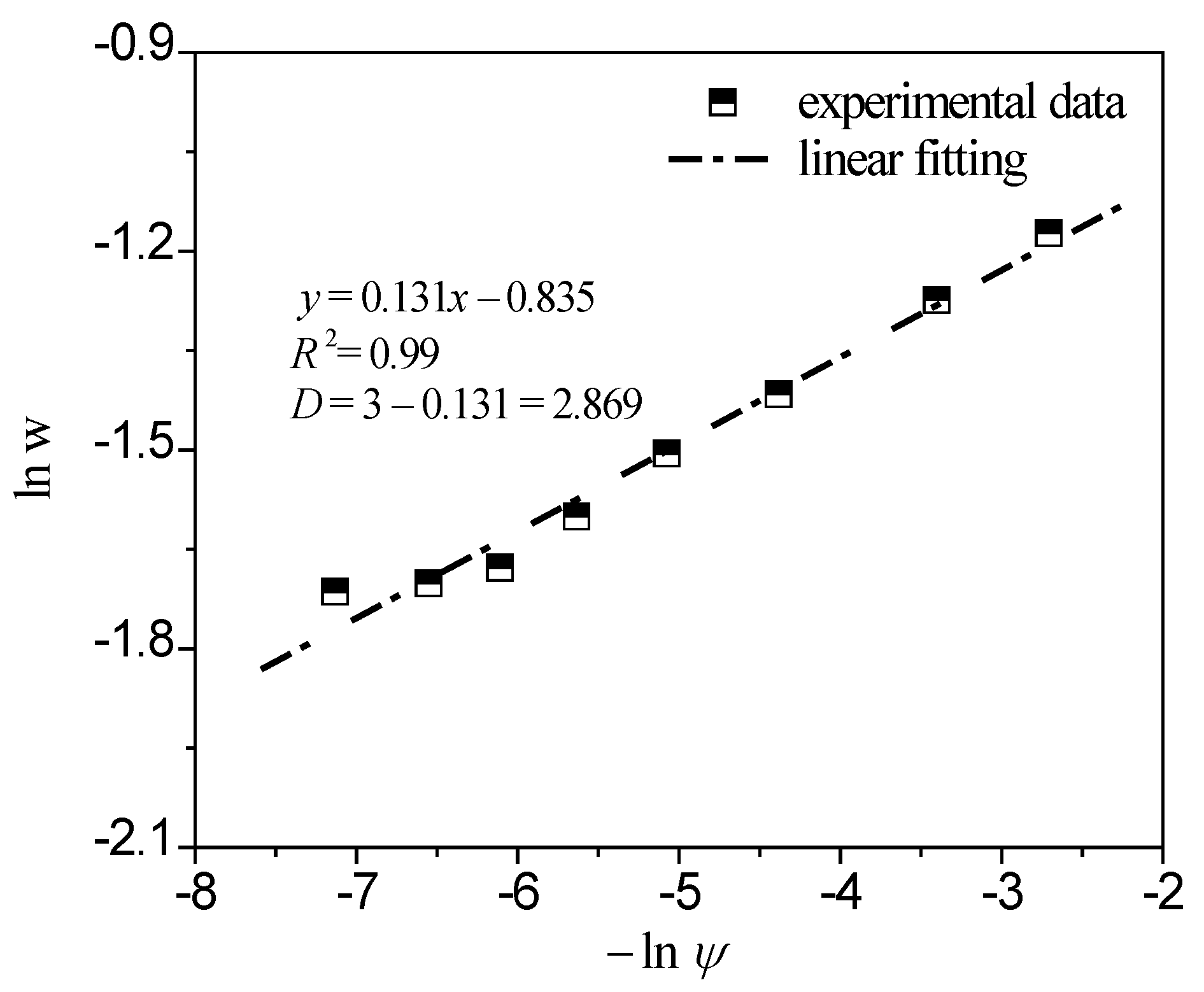

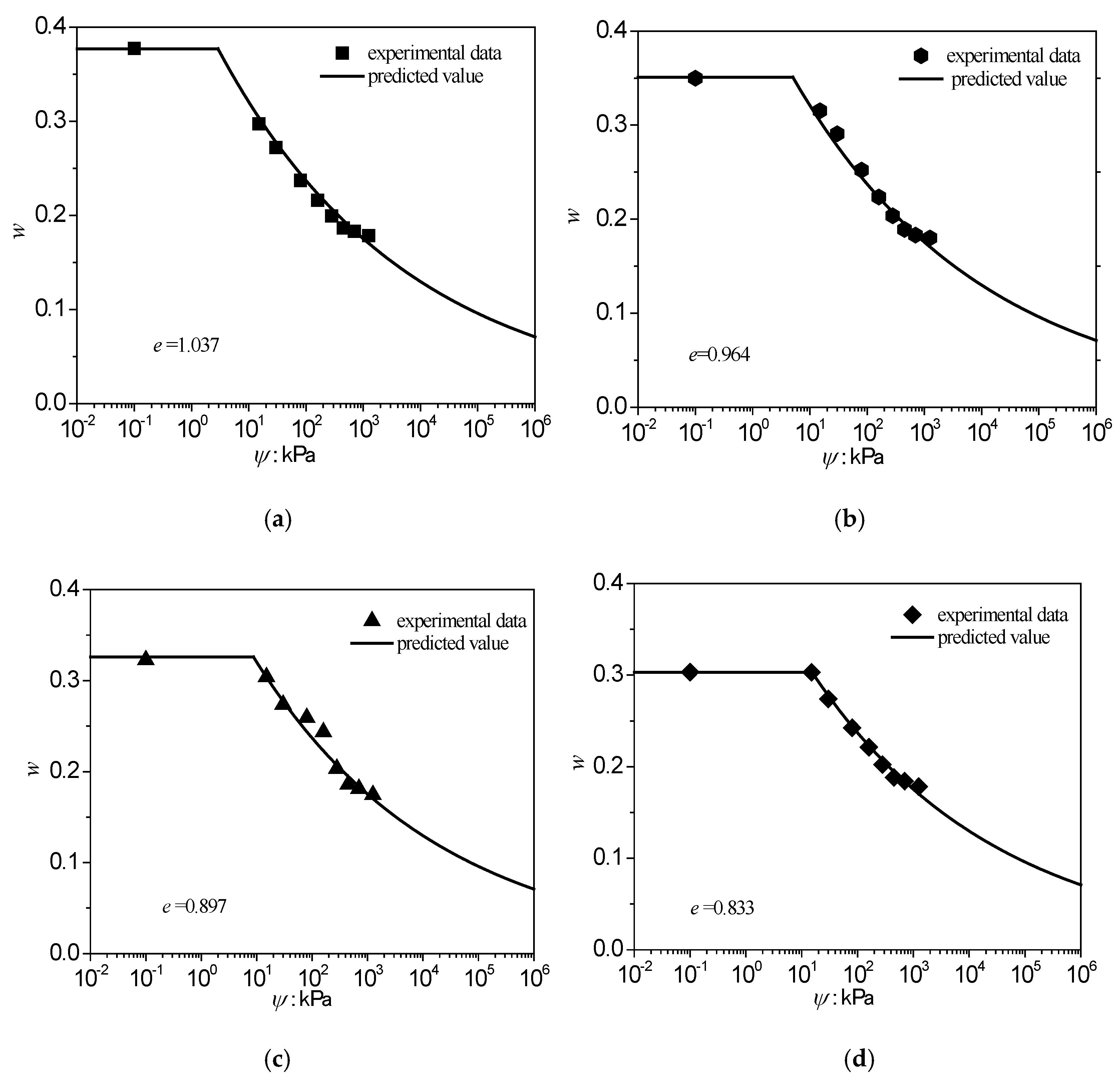
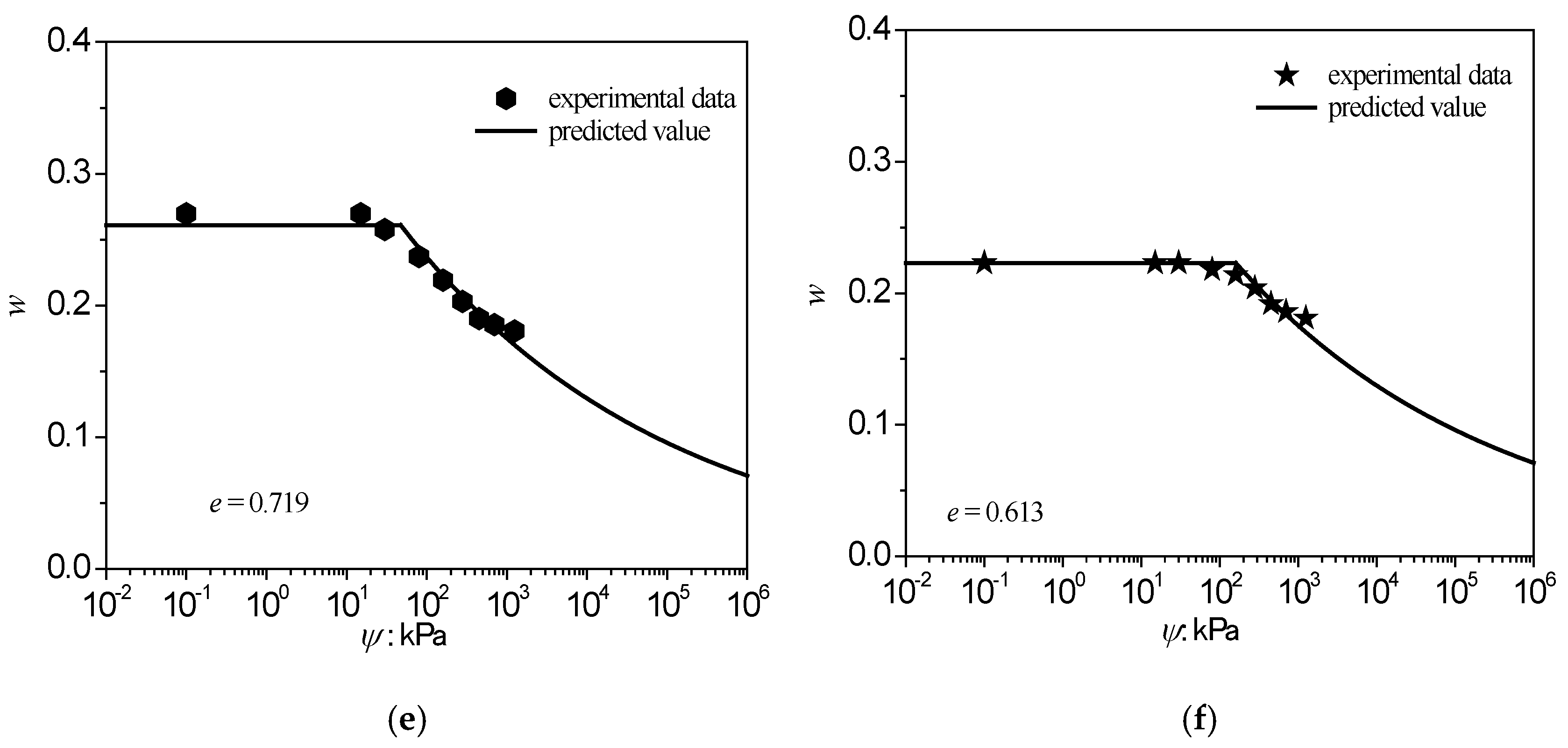
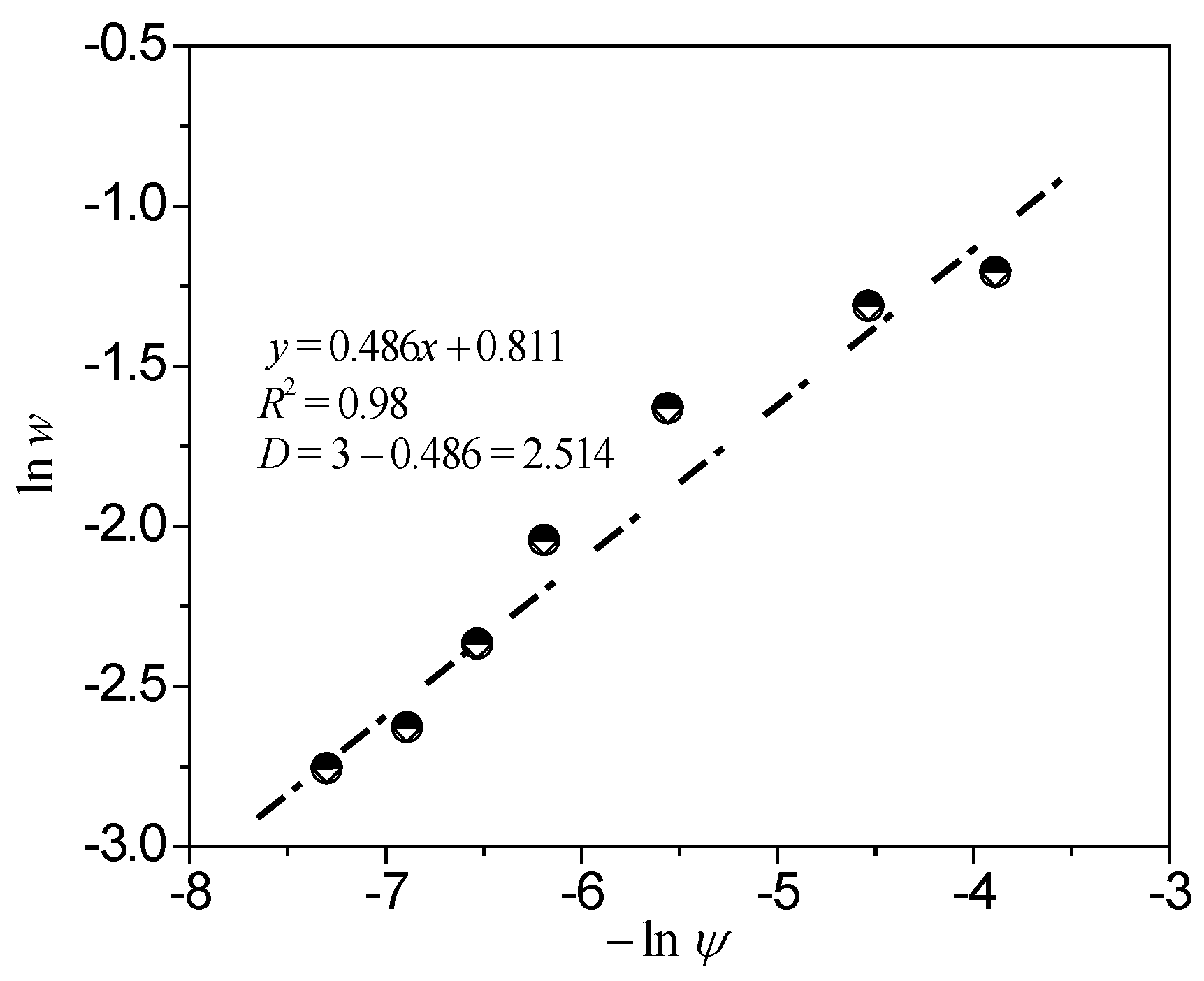
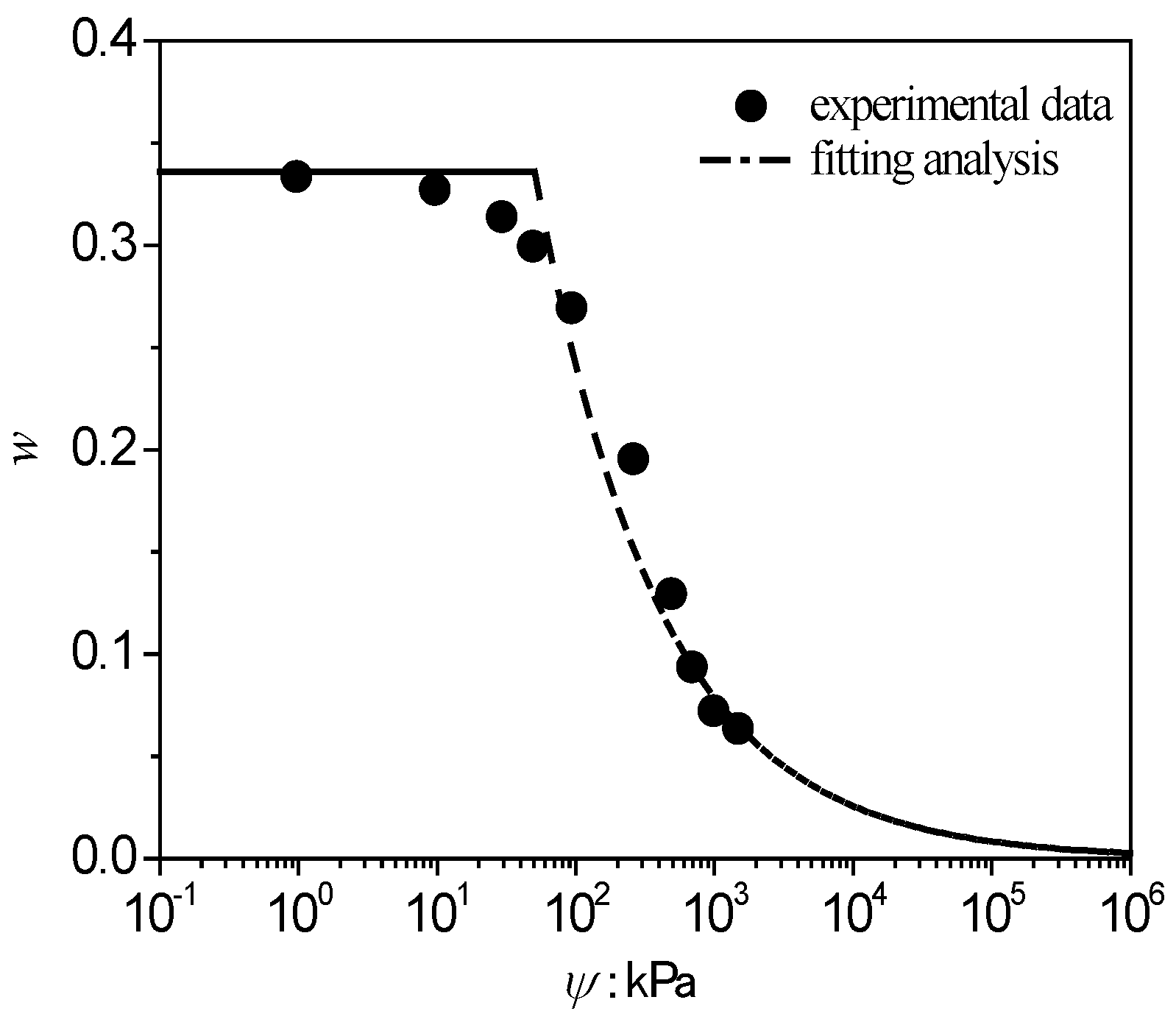
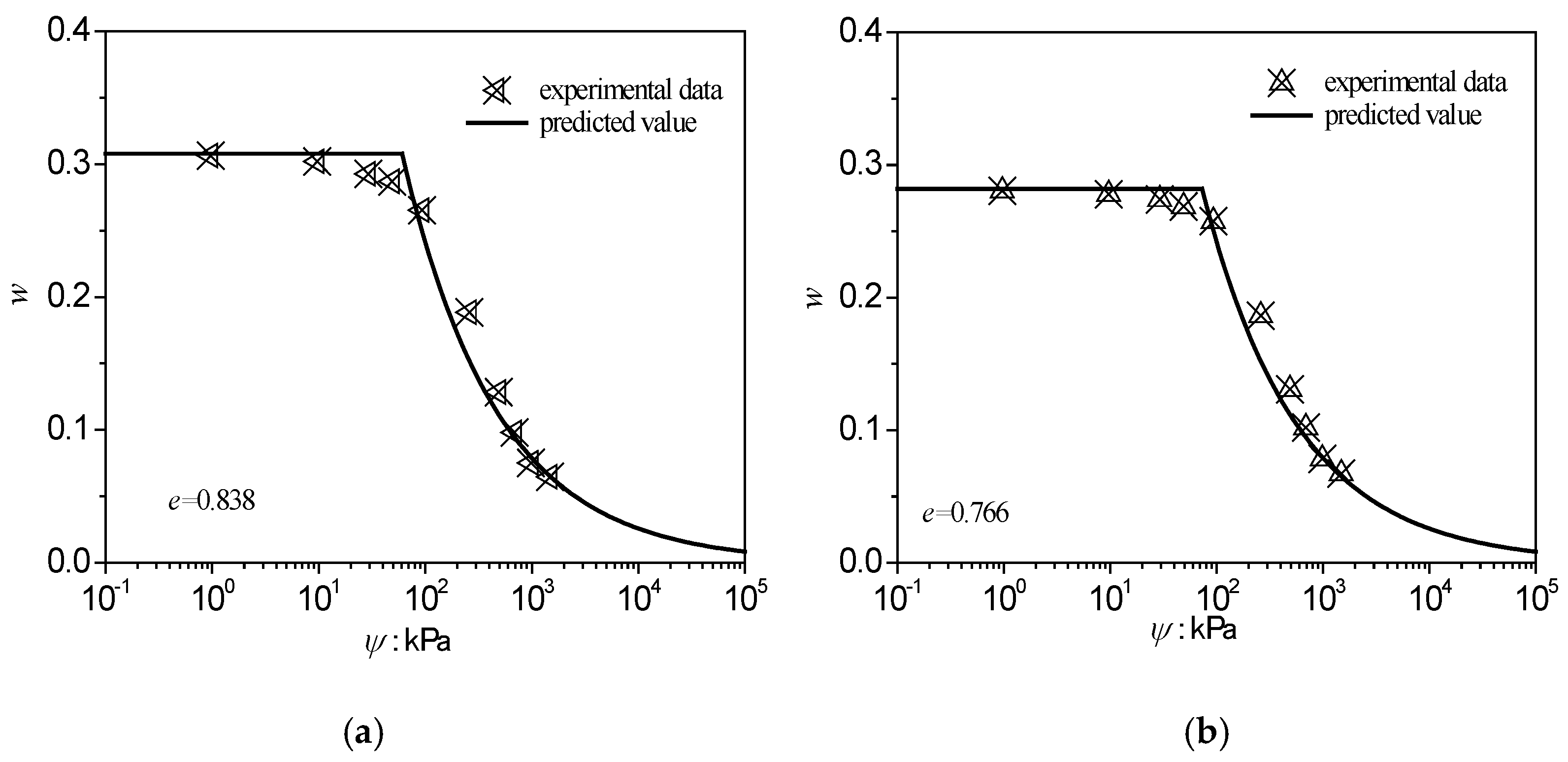
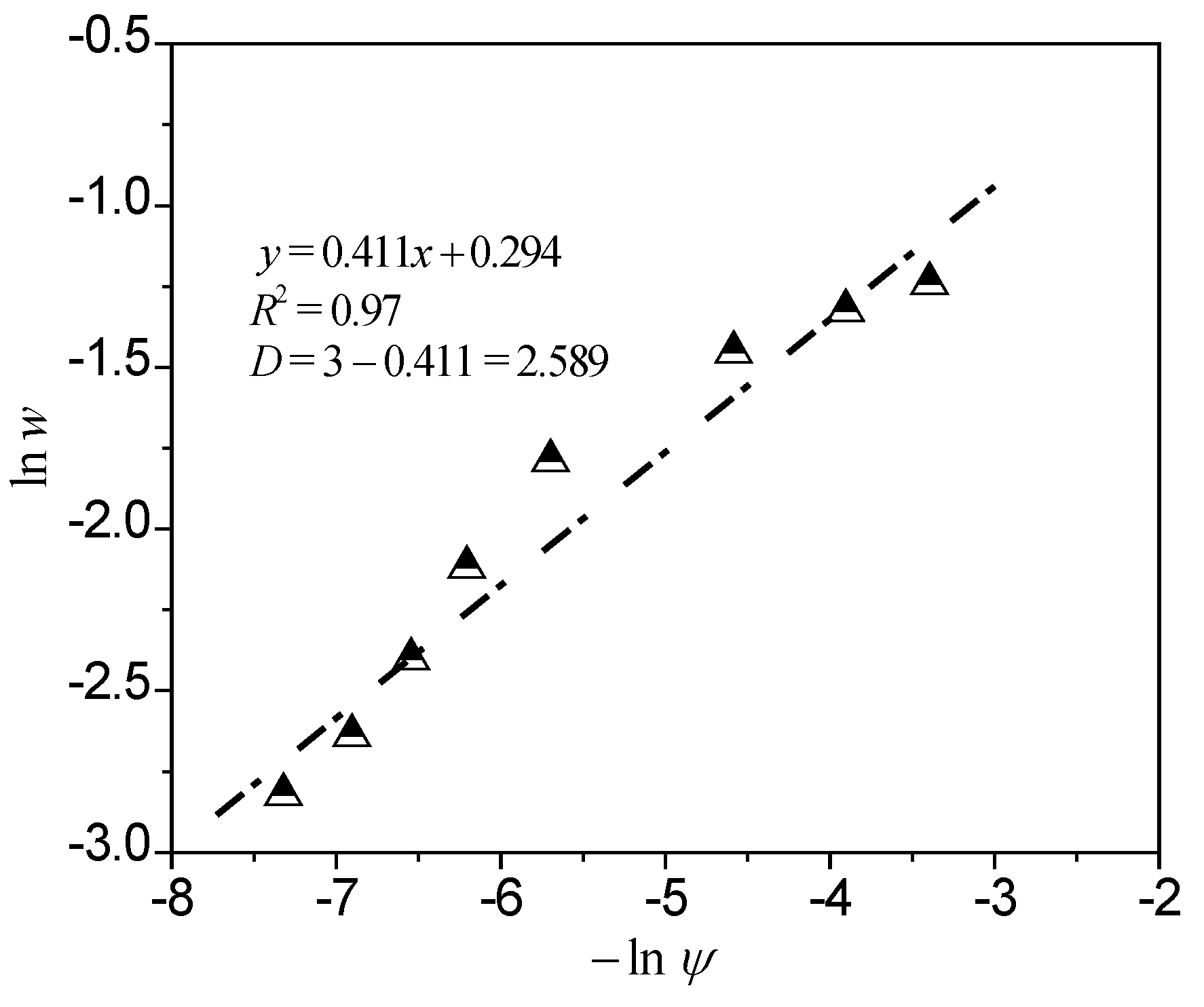
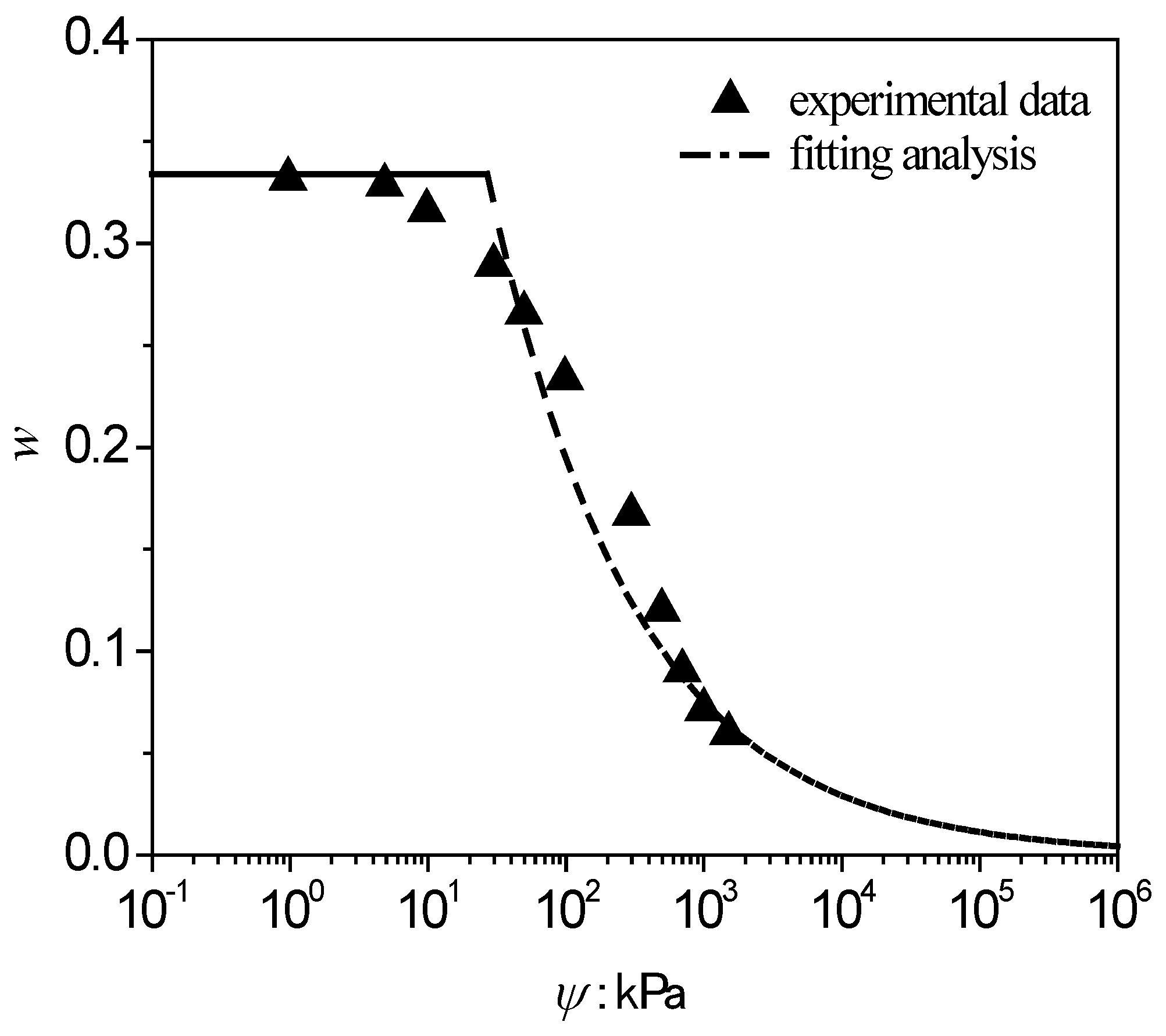
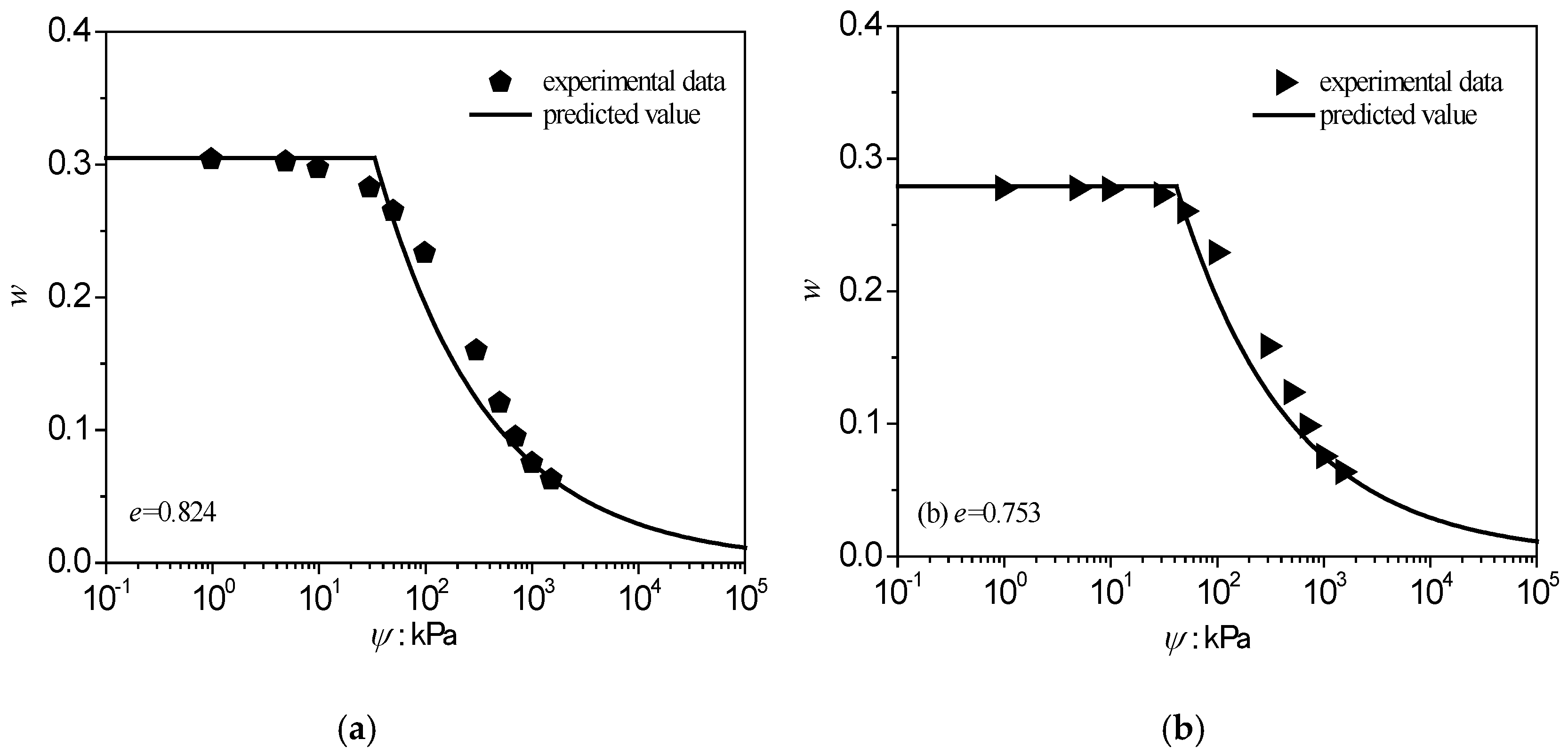
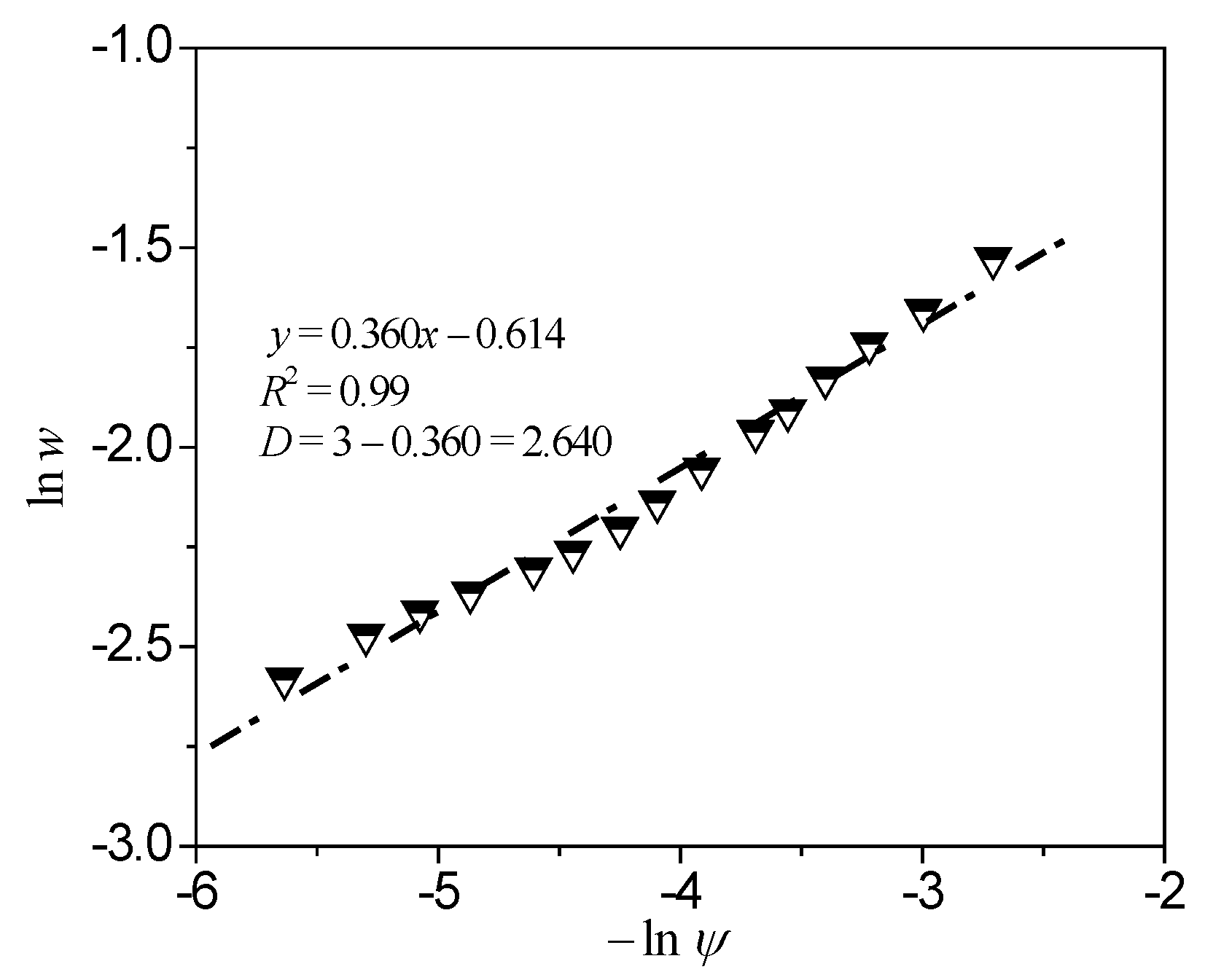
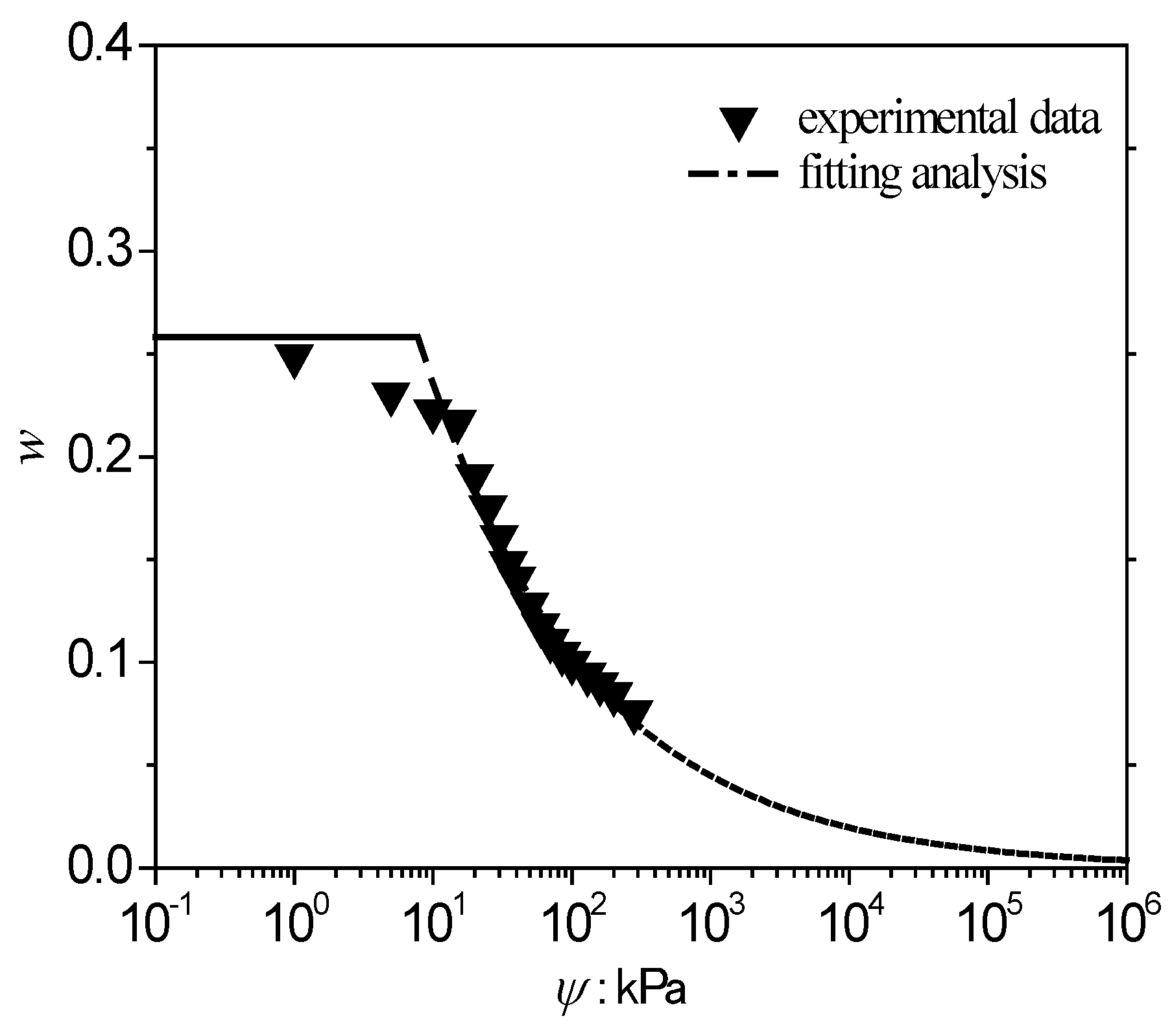

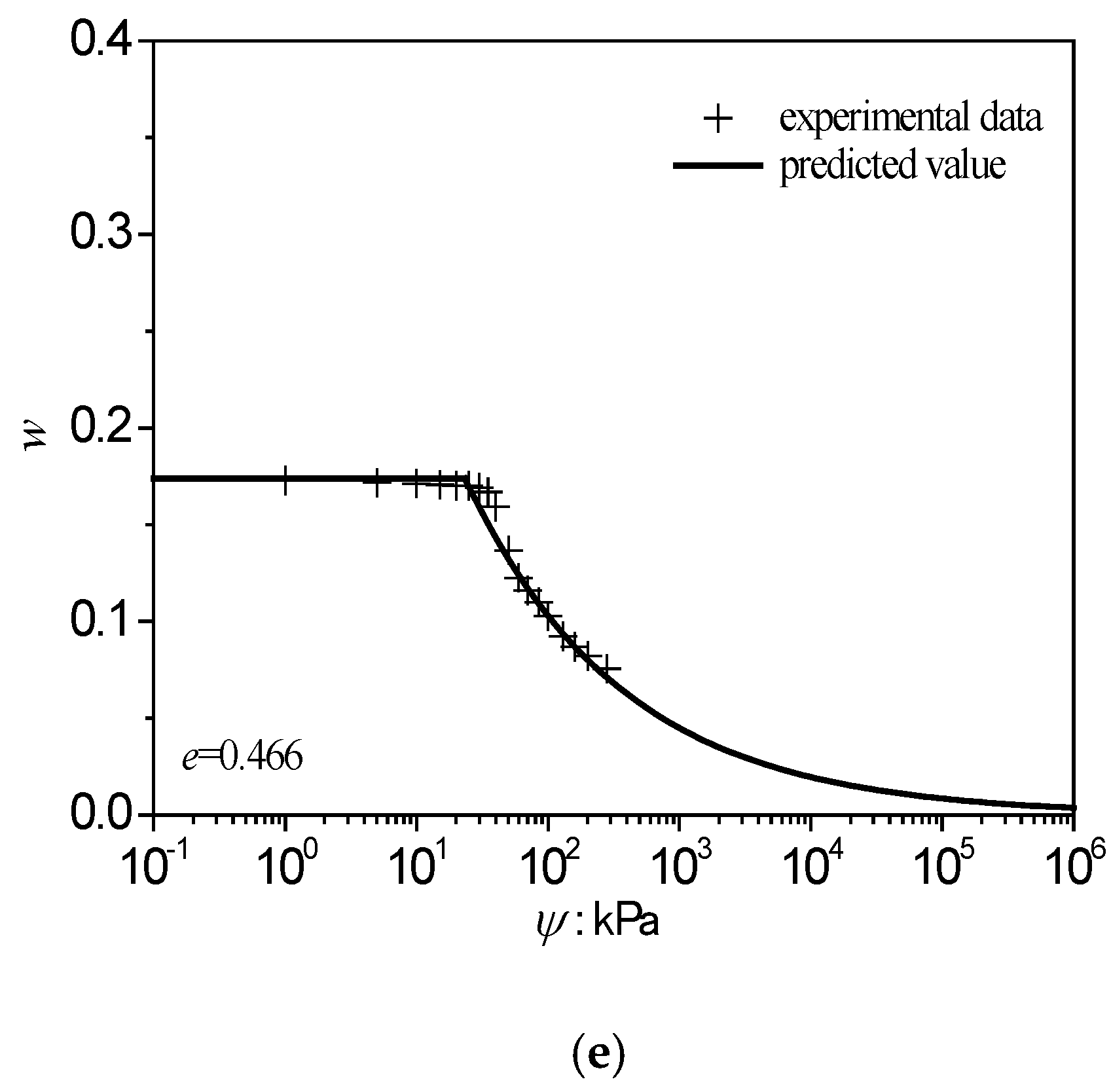

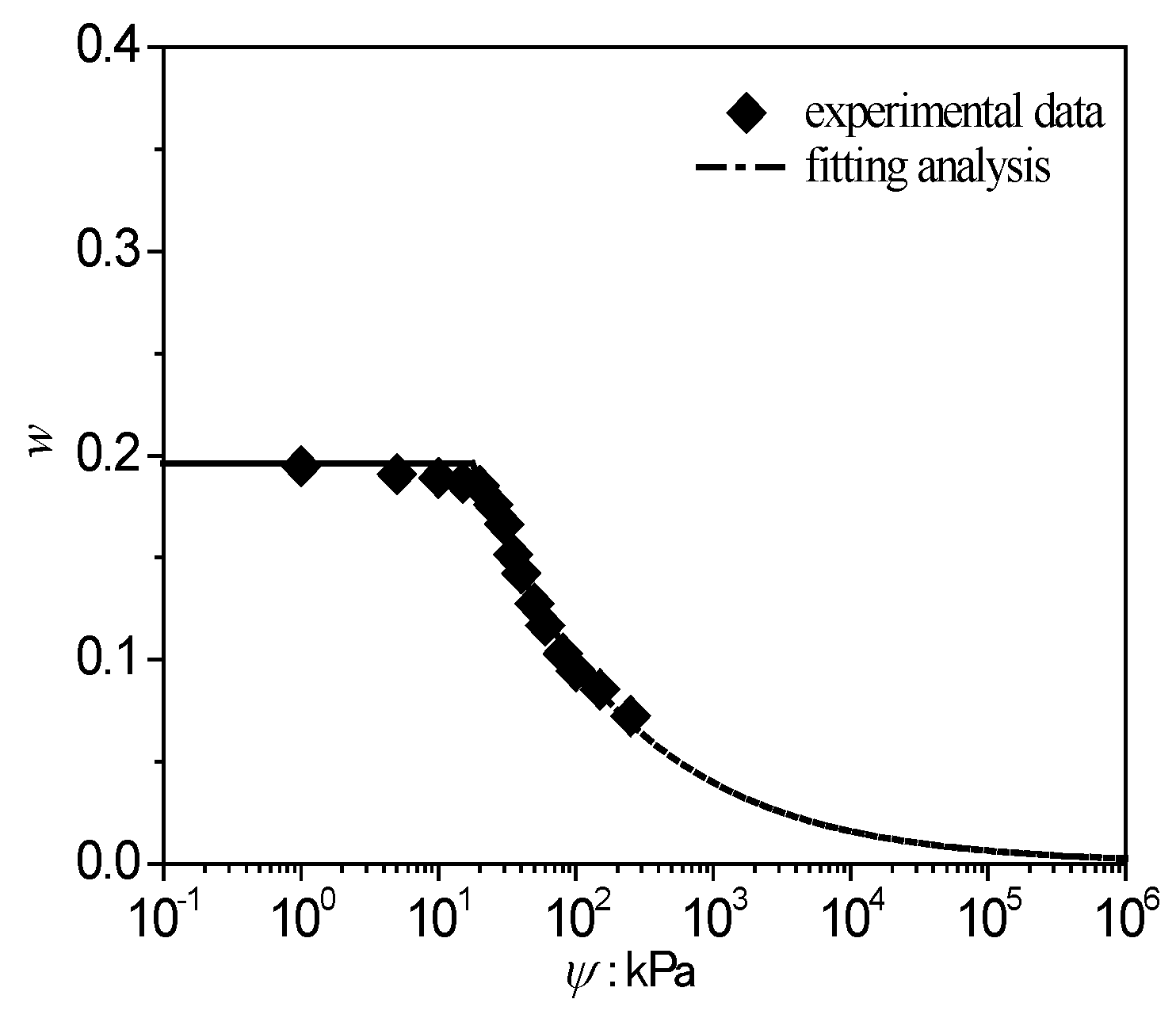
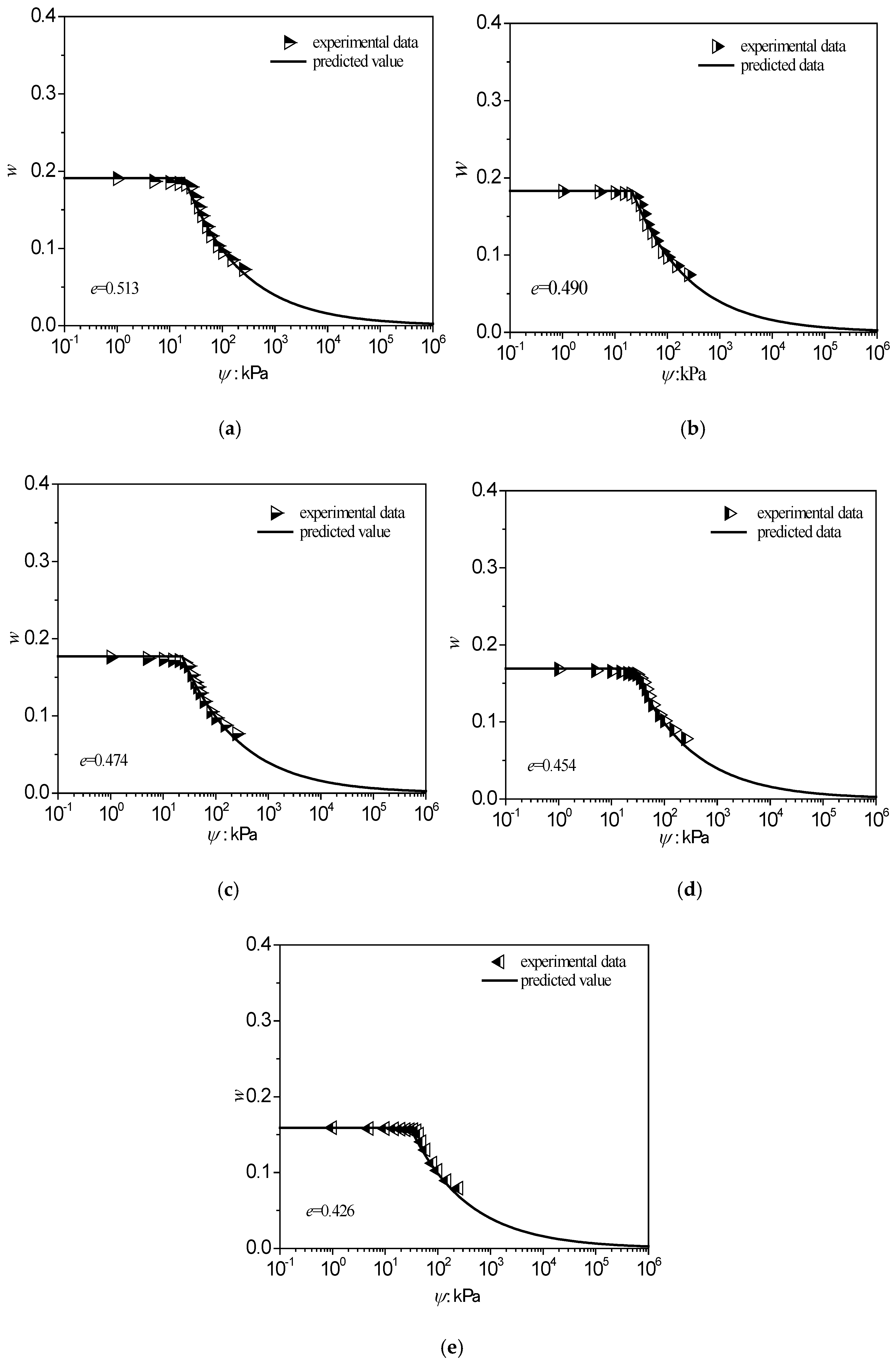

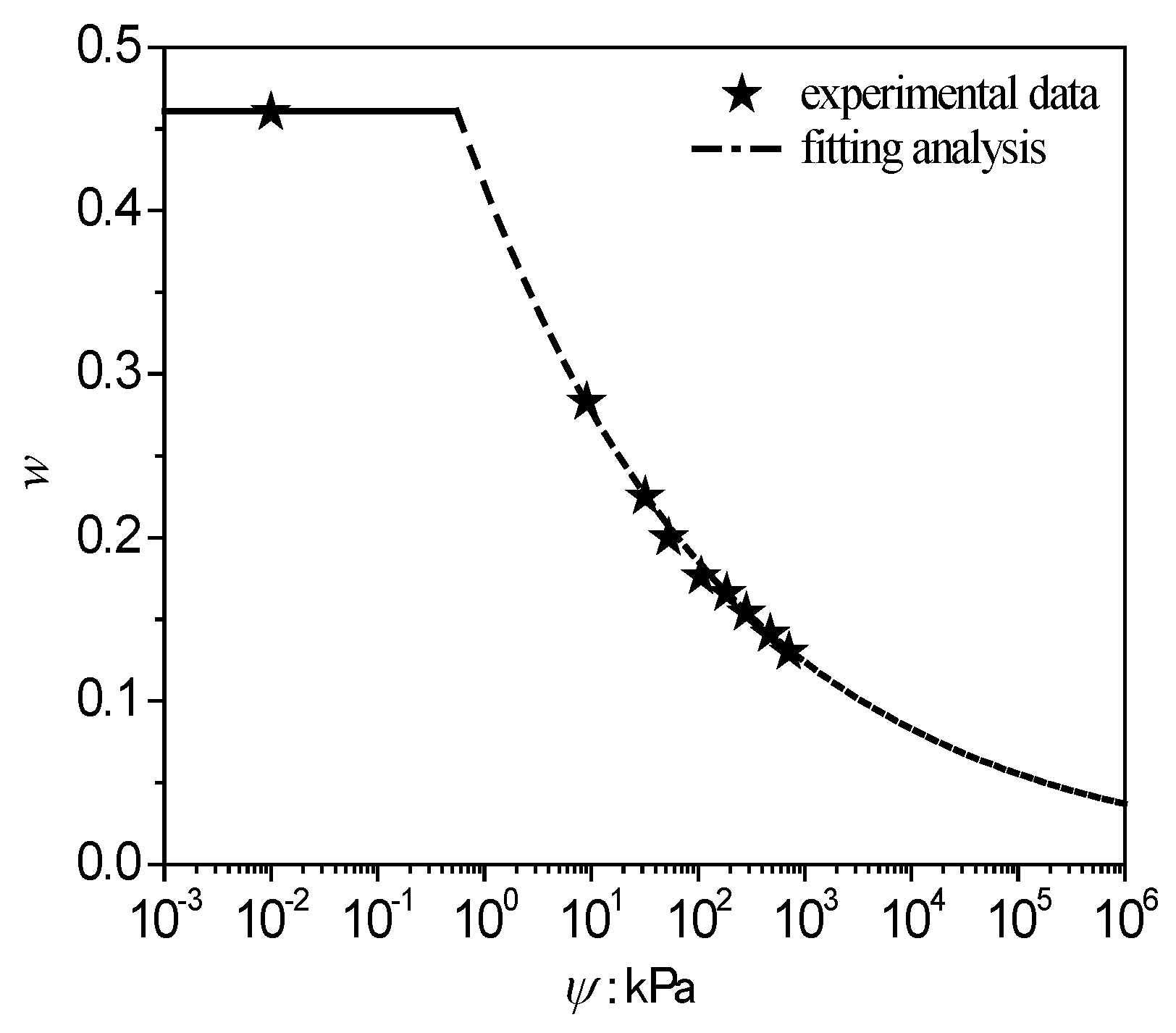

| Natural Density (g/cm3) | Relative Density | Natural Water Content (%) | Liquid Limit (%) | Plastic Limit (%) |
|---|---|---|---|---|
| 2.03 | 2.75 | 21.9 | 38.9 | 20.4 |
| Soil Type | Initial Void Ratio | Fractal Dimension | Air-Entry Value/kPa | Soil Type | Initial Void Ratio | Fractal Dimension | Air-Entry Value/kPa |
|---|---|---|---|---|---|---|---|
| Wuhan clay | 1.037 0.964 0.897 0.833 0.719 0.613 | 2.869 | 2.89 5.04 8.74 15.37 47.28 159.74 | Saskatchewan silt/T1 | 0.54 0.528 0.501 0.483 0.466 | 2.640 | 15.50 16.50 19.08 21.12 23.33 |
| Hefei expansive soil | 0.838 0.766 | 2.514 | 60.58 72.89 | Saskatchewan silt/T2 | 0.513 0.490 0.474 0.454 0.426 | 2.604 | 18.77 21.08 22.92 25.56 30.02 |
| Guangxi expansive soil | 0.824 0.753 | 2.589 | 33.28 41.44 | Xian Loess (5 °C) | 0.88 0.75 0.72 | 2.825 | 3.73 9.29 11.73 |
| Relative Density | Liquid Limit (%) | Plastic Limit (%) | Plasticity Index (%) |
|---|---|---|---|
| 2.72 | 58.6 | 26.4 | 32.2 |
| Relative Density | Liquid Limit (%) | Plastic Limit (%) | Plasticity Index (%) |
|---|---|---|---|
| 2.70 | 61.4 | 30.3 | 31.1 |
| Relative Density | Natural Water Content (%) | Liquid Limit (%) | Plastic Limit (%) | Plastic Index (%) |
|---|---|---|---|---|
| 2.68 | 0.86 | 22.2 | 16.6 | 5.6 |
| Depth | Liquid Limit (%) | Plastic Limit (%) | Plastic Index (%) |
|---|---|---|---|
| 2.68 | 30.7 | 18.4 | 12.3 |
© 2018 by the authors. Licensee MDPI, Basel, Switzerland. This article is an open access article distributed under the terms and conditions of the Creative Commons Attribution (CC BY) license (http://creativecommons.org/licenses/by/4.0/).
Share and Cite
Tao, G.; Chen, Y.; Kong, L.; Xiao, H.; Chen, Q.; Xia, Y. A Simple Fractal-Based Model for Soil-Water Characteristic Curves Incorporating Effects of Initial Void Ratios. Energies 2018, 11, 1419. https://doi.org/10.3390/en11061419
Tao G, Chen Y, Kong L, Xiao H, Chen Q, Xia Y. A Simple Fractal-Based Model for Soil-Water Characteristic Curves Incorporating Effects of Initial Void Ratios. Energies. 2018; 11(6):1419. https://doi.org/10.3390/en11061419
Chicago/Turabian StyleTao, Gaoliang, Yin Chen, Lingwei Kong, Henglin Xiao, Qingsheng Chen, and Yuxuan Xia. 2018. "A Simple Fractal-Based Model for Soil-Water Characteristic Curves Incorporating Effects of Initial Void Ratios" Energies 11, no. 6: 1419. https://doi.org/10.3390/en11061419





